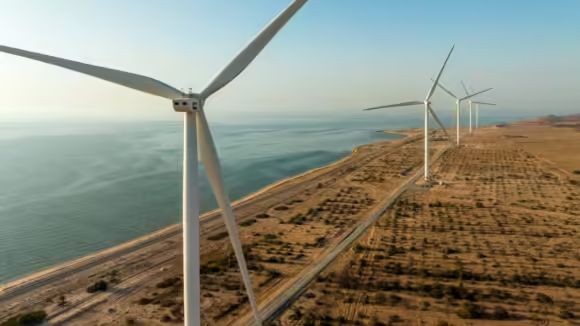Masdar, the largest renewable energy company in the Middle East, has unveiled its ambitious plan to increase its wind and solar capacity to 100 gigawatts by the end of the decade—an amount comparable to the total power generation of the UK.
If successful, the Abu Dhabi-based company will position itself among the world’s leading renewable energy firms, surpassing competitors like Spain’s Iberdrola, France’s Engie, and Germany’s RWE.
Partially owned by the state oil giant Adnoc, the state water and power company Taqa, and the sovereign investment fund Mubadala, Masdar aims to continue its global investment expansion. This year alone, it has announced nearly €6.5 billion in deals in Spain and Greece.
In the United States, Masdar has completed the acquisition of Terra-Gen, one of the nation’s largest renewable energy companies. In the UK, it holds a 49 percent stake in the £11 billion Dogger Bank South project, which is set to become one of the largest offshore wind farms in the world upon completion.
Mohamed Jameel Al Ramahi, Masdar’s CEO, expressed the company’s commitment to significant investments in the Middle East, Europe, and the U.S., the latter being the second-largest renewable energy market after China. In an interview, he outlined the geographic distribution of Masdar’s power generation by 2030, estimating that approximately 30 to 35 percent would come from the Middle East, 20 percent from Europe, and 20 to 25 percent from the U.S., with the remainder from Asia.
Al Ramahi emphasized the company’s goal of achieving a balanced split between solar and wind projects. Although renewable projects in Europe may come at a premium, he affirmed that Masdar would invest in regions where energy markets are open to foreign investments.
“To reach my target of 100 gigawatts, I cannot ignore Europe or the U.S.,” he stated.
While Italian company Enel also aims for 154 gigawatts of renewable energy by the same deadline, it has recently initiated an asset sales program to reduce its debt.
Masdar’s strategy this year has focused on acquiring not only assets but also experienced teams in the U.S. and Spain, aiming to build regional platforms. “More important than size is the team,” Al Ramahi noted, referring to the Terra-Gen acquisition.
He recognized that competition in the renewable sector has intensified as private equity firms and financial investors have entered the market. “This is very positive,” he said, recalling a time when banks were reluctant to finance renewable projects. However, he also acknowledged that increased competition raises asset valuations, which can complicate market dynamics if investors decide to exit.
Ultimately, Al Ramahi pointed out that renewable energy is a utility business that should yield single-digit returns. “We are not financial investors at Masdar,” he clarified. “We invest significant capital, but we are strategic investors, and our returns are naturally compressed because we operate as a utility. We are not looking to recycle these projects every four or five years.”
This story has been updated to clarify that the Dogger Bank project will be one of the world’s largest offshore wind farms upon completion, rather than the largest.










